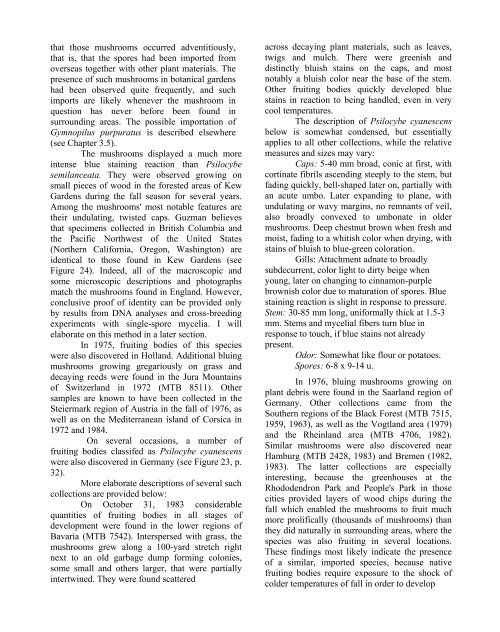Jochen Gartz - Magic Mushrooms Around the ... - preterhuman.net
Jochen Gartz - Magic Mushrooms Around the ... - preterhuman.net
Jochen Gartz - Magic Mushrooms Around the ... - preterhuman.net
Create successful ePaper yourself
Turn your PDF publications into a flip-book with our unique Google optimized e-Paper software.
that those mushrooms occurred adventitiously,<br />
that is, that <strong>the</strong> spores had been imported from<br />
overseas toge<strong>the</strong>r with o<strong>the</strong>r plant materials. The<br />
presence of such mushrooms in botanical gardens<br />
had been observed quite frequently, and such<br />
imports are likely whenever <strong>the</strong> mushroom in<br />
question has never before been found in<br />
surrounding areas. The possible importation of<br />
Gymnopilus purpuratus is described elsewhere<br />
(see Chapter 3.5).<br />
The mushrooms displayed a much more<br />
intense blue staining reaction than Psilocybe<br />
semilanceata. They were observed growing on<br />
small pieces of wood in <strong>the</strong> forested areas of Kew<br />
Gardens during <strong>the</strong> fall season for several years.<br />
Among <strong>the</strong> mushrooms' most notable features are<br />
<strong>the</strong>ir undulating, twisted caps. Guzman believes<br />
that specimens collected in British Columbia and<br />
<strong>the</strong> Pacific Northwest of <strong>the</strong> United States<br />
(Nor<strong>the</strong>rn California, Oregon, Washington) are<br />
identical to those found in Kew Gardens (see<br />
Figure 24). Indeed, all of <strong>the</strong> macroscopic and<br />
some microscopic descriptions and photographs<br />
match <strong>the</strong> mushrooms found in England. However,<br />
conclusive proof of identity can be provided only<br />
by results from DNA analyses and cross-breeding<br />
experiments with single-spore mycelia. I will<br />
elaborate on this method in a later section.<br />
In 1975, fruiting bodies of this species<br />
were also discovered in Holland. Additional bluing<br />
mushrooms growing gregariously on grass and<br />
decaying reeds were found in <strong>the</strong> Jura Mountains<br />
of Switzerland in 1972 (MTB 8511). O<strong>the</strong>r<br />
samples are known to have been collected in <strong>the</strong><br />
Steiermark region of Austria in <strong>the</strong> fall of 1976, as<br />
well as on <strong>the</strong> Mediterranean island of Corsica in<br />
1972 and 1984.<br />
On several occasions, a number of<br />
fruiting bodies classifed as Psilocybe cyanescens<br />
were also discovered in Germany (see Figure 23, p.<br />
32).<br />
More elaborate descriptions of several such<br />
collections are provided below:<br />
On October 31, 1983 considerable<br />
quantities of fruiting bodies in all stages of<br />
development were found in <strong>the</strong> lower regions of<br />
Bavaria (MTB 7542). Interspersed with grass, <strong>the</strong><br />
mushrooms grew along a 100-yard stretch right<br />
next to an old garbage dump forming colonies,<br />
some small and o<strong>the</strong>rs larger, that were partially<br />
intertwined. They were found scattered<br />
across decaying plant materials, such as leaves,<br />
twigs and mulch. There were greenish and<br />
distinctly bluish stains on <strong>the</strong> caps, and most<br />
notably a bluish color near <strong>the</strong> base of <strong>the</strong> stem.<br />
O<strong>the</strong>r fruiting bodies quickly developed blue<br />
stains in reaction to being handled, even in very<br />
cool temperatures.<br />
The description of Psilocybe cyanescens<br />
below is somewhat condensed, but essentially<br />
applies to all o<strong>the</strong>r collections, while <strong>the</strong> relative<br />
measures and sizes may vary:<br />
Caps: 5-40 mm broad, conic at first, with<br />
cortinate fibrils ascending steeply to <strong>the</strong> stem, but<br />
fading quickly, bell-shaped later on, partially with<br />
an acute umbo. Later expanding to plane, with<br />
undulating or wavy margins, no remnants of veil,<br />
also broadly convexed to umbonate in older<br />
mushrooms. Deep chestnut brown when fresh and<br />
moist, fading to a whitish color when drying, with<br />
stains of bluish to blue-green coloration.<br />
Gills: Attachment adnate to broadly<br />
subdecurrent, color light to dirty beige when<br />
young, later on changing to cinnamon-purple<br />
brownish color due to maturation of spores. Blue<br />
staining reaction is slight in response to pressure.<br />
Stem: 30-85 mm long, uniformally thick at 1.5-3<br />
mm. Stems and mycelial fibers turn blue in<br />
response to touch, if blue stains not already<br />
present.<br />
Odor: Somewhat like flour or potatoes.<br />
Spores: 6-8 x 9-14 u.<br />
In 1976, bluing mushrooms growing on<br />
plant debris were found in <strong>the</strong> Saarland region of<br />
Germany. O<strong>the</strong>r collections came from <strong>the</strong><br />
Sou<strong>the</strong>rn regions of <strong>the</strong> Black Forest (MTB 7515,<br />
1959, 1963), as well as <strong>the</strong> Vogtland area (1979)<br />
and <strong>the</strong> Rheinland area (MTB 4706, 1982).<br />
Similar mushrooms were also discovered near<br />
Hamburg (MTB 2428, 1983) and Bremen (1982,<br />
1983). The latter collections are especially<br />
interesting, because <strong>the</strong> greenhouses at <strong>the</strong><br />
Rhododendron Park and People's Park in those<br />
cities provided layers of wood chips during <strong>the</strong><br />
fall which enabled <strong>the</strong> mushrooms to fruit much<br />
more prolifically (thousands of mushrooms) than<br />
<strong>the</strong>y did naturally in surrounding areas, where <strong>the</strong><br />
species was also fruiting in several locations.<br />
These findings most likely indicate <strong>the</strong> presence<br />
of a similar, imported species, because native<br />
fruiting bodies require exposure to <strong>the</strong> shock of<br />
colder temperatures of fall in order to develop








![The Big Lie 9-11 and Government Complicity in Mass Murder [PDF]](https://img.yumpu.com/50957077/1/190x245/the-big-lie-9-11-and-government-complicity-in-mass-murder-pdf.jpg?quality=85)








